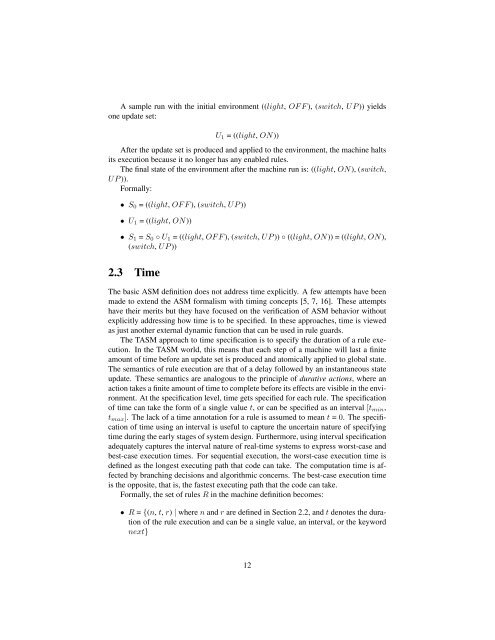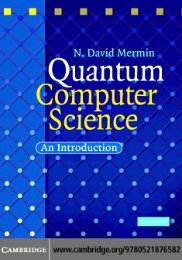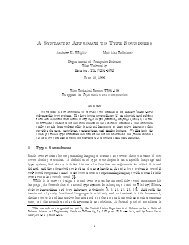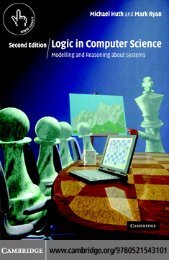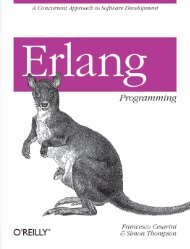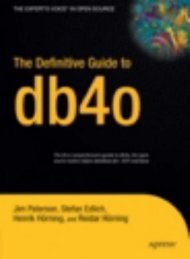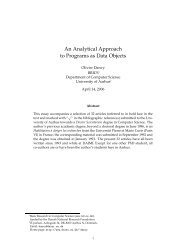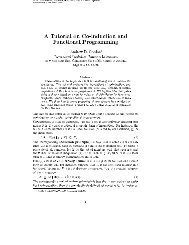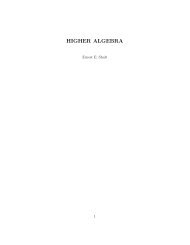The TASM Language Reference Manual Version 1.1 - Synrc
The TASM Language Reference Manual Version 1.1 - Synrc
The TASM Language Reference Manual Version 1.1 - Synrc
Create successful ePaper yourself
Turn your PDF publications into a flip-book with our unique Google optimized e-Paper software.
A sample run with the initial environment ((light, OF F ), (switch, UP )) yields<br />
one update set:<br />
U 1 = ((light, ON))<br />
After the update set is produced and applied to the environment, the machine halts<br />
its execution because it no longer has any enabled rules.<br />
<strong>The</strong> final state of the environment after the machine run is: ((light, ON), (switch,<br />
UP )).<br />
Formally:<br />
• S 0 = ((light, OF F ), (switch, UP ))<br />
• U 1 = ((light, ON))<br />
• S 1 = S 0 ◦ U 1 = ((light, OF F ), (switch, UP )) ◦ ((light, ON)) = ((light, ON),<br />
(switch, UP ))<br />
2.3 Time<br />
<strong>The</strong> basic ASM definition does not address time explicitly. A few attempts have been<br />
made to extend the ASM formalism with timing concepts [5, 7, 16]. <strong>The</strong>se attempts<br />
have their merits but they have focused on the verification of ASM behavior without<br />
explicitly addressing how time is to be specified. In these approaches, time is viewed<br />
as just another external dynamic function that can be used in rule guards.<br />
<strong>The</strong> <strong>TASM</strong> approach to time specification is to specify the duration of a rule execution.<br />
In the <strong>TASM</strong> world, this means that each step of a machine will last a finite<br />
amount of time before an update set is produced and atomically applied to global state.<br />
<strong>The</strong> semantics of rule execution are that of a delay followed by an instantaneous state<br />
update. <strong>The</strong>se semantics are analogous to the principle of durative actions, where an<br />
action takes a finite amount of time to complete before its effects are visible in the environment.<br />
At the specification level, time gets specified for each rule. <strong>The</strong> specification<br />
of time can take the form of a single value t, or can be specified as an interval [t min ,<br />
t max ]. <strong>The</strong> lack of a time annotation for a rule is assumed to mean t = 0. <strong>The</strong> specification<br />
of time using an interval is useful to capture the uncertain nature of specifying<br />
time during the early stages of system design. Furthermore, using interval specification<br />
adequately captures the interval nature of real-time systems to express worst-case and<br />
best-case execution times. For sequential execution, the worst-case execution time is<br />
defined as the longest executing path that code can take. <strong>The</strong> computation time is affected<br />
by branching decisions and algorithmic concerns. <strong>The</strong> best-case execution time<br />
is the opposite, that is, the fastest executing path that the code can take.<br />
Formally, the set of rules R in the machine definition becomes:<br />
• R = {(n, t, r) | where n and r are defined in Section 2.2, and t denotes the duration<br />
of the rule execution and can be a single value, an interval, or the keyword<br />
next}<br />
12


